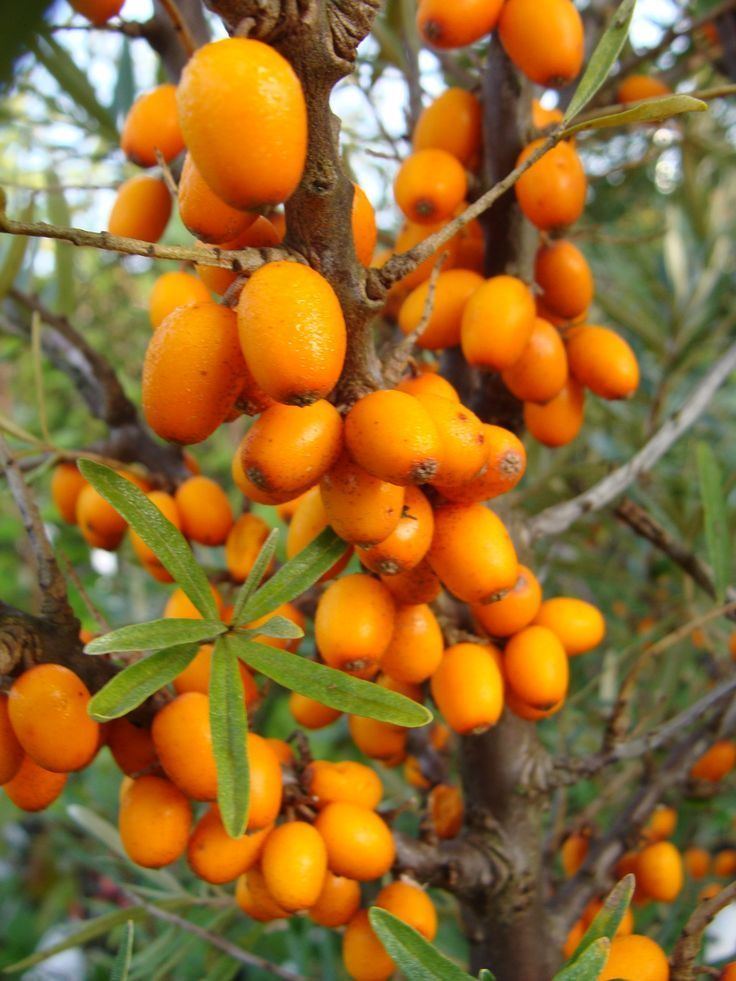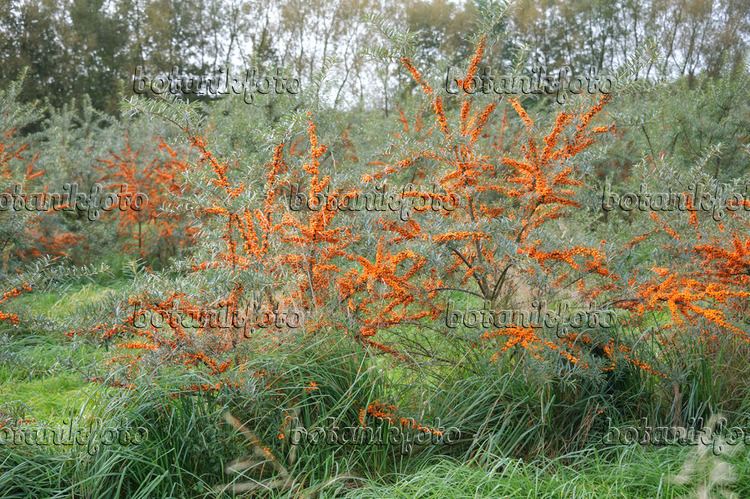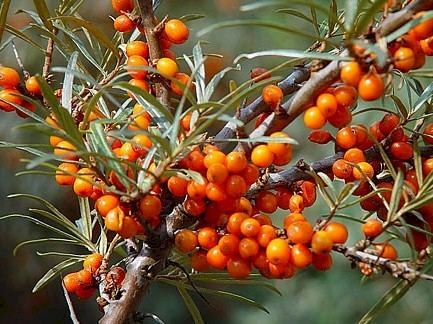Scientific name Hippophae Rank Genus | ||
Similar Buckthorn, Elaeagnaceae, Mountain‑ash, Currant, Cranberry | ||
Planting seaberry plant sea buckthorn part 1 hippophae rhamnoides star of altai
Hippophae is a genus of sea buckthorns, deciduous shrubs in the family Elaeagnaceae. The name sea buckthorn may be hyphenated to avoid confusion with the buckthorns (Rhamnus, family Rhamnaceae). It is also referred to as sandthorn, sallowthorn, or seaberry.
Contents
- Planting seaberry plant sea buckthorn part 1 hippophae rhamnoides star of altai
- Hippophae rhamnoides common sea buckthorn
- Taxonomy
- Distribution
- Description
- Species
- Natural history
- Fruit harvesting
- Products
- Landscape uses
- Fruit
- Traditional medicine
- Research
- Organizations
- References

Hippophae rhamnoides common sea buckthorn
Taxonomy

In ancient times, leaves and young branches from sea buckthorn were supposedly fed as a remedy to horses to support weight gain and appearance of the coat, thus leading to the name of the genus, Hippophae derived from hippo (horse), and phaos (shining).
Distribution

Seven species are recognized, two of them probably of hybrid origin, native over a wide area of Europe and Asia.

Hippophae rhamnoides, the common sea buckthorn, is by far the most widespread of the species in the genus, with the ranges of its eight subspecies extending from the Atlantic coasts of Europe across to northwestern Mongolia and northwestern China. In western Europe, it is largely confined to sea coasts where salt spray off the sea prevents other larger plants from outcompeting it, but in central Asia, it is more widespread in dry semidesert sites where other plants cannot survive the dry conditions.

In central Europe and Asia, it also occurs as a sub-alpine shrub above the tree line in mountains, and other sunny areas such as river banks. They are tolerant of salt in the air and soil, but demand full sunlight for good growth and do not tolerate shady conditions near larger trees. They typically grow in dry, sandy areas.

More than 90% or about 1,500,000 ha (5,800 sq mi) of the world's natural sea buckthorn habitat is found in China, Mongolia, Russia, northern Europe, and Canada, where the plant is used for soil, water and wildlife conservation, antidesertification purposes, and consumer products.
Sea buckthorn USDA hardiness zones are about 3 through 7.
Description
The shrubs reach 0.5–6 metres (1.6–19.7 ft) tall, rarely up to 10 metres (33 ft) in central Asia. The leaf arrangement can be alternate or opposite.
Common sea buckthorn has dense and stiff branches, and are very thorny. The leaves are a distinct pale silvery-green, lanceolate, 3–8 cm (1.2–3.1 in) long, and less than 7 mm (0.28 in) broad. It is dioecious, with separate male and female plants. The male produces brownish flowers which produce wind-distributed pollen. The female plants produce orange berries 6–9 mm (0.24–0.35 in) in diameter, soft, juicy, and rich in oils. The roots distribute rapidly and extensively, providing a nonleguminous nitrogen fixation role in surrounding soils.
Hippophae salicifolia (willow-leaved sea buckthorn) is restricted to the Himalayas, to the south of the common sea buckthorn, growing at high altitudes in dry valleys; it differs from H. rhamnoides in having broader (to 10 mm (0.39 in)) and greener (less silvery) leaves, and yellow berries. A wild variant occurs in the same area, but at even higher altitudes in the alpine zone. It is a low shrub not growing taller than 1 m (3.3 ft) with small leaves 1–3 cm (0.39–1.18 in) long.
Species
A study of nuclear ribosomal internal transcribed spacer sequence data showed that the genus can be divided into three monophyletic clades:
A study using chloroplast sequences and morphology, however, recovered only two clades:
Natural history
The fruit is an important winter food resource for some birds, notably fieldfares.
Leaves are eaten by the larva of the coastal race of the ash pug moth and by larvae of other Lepidoptera, including brown-tail, dun-bar, emperor moth, mottled umber, and Coleophora elaeagnisella.
Fruit harvesting
Harvesting is difficult because of the dense thorn arrangement among the berries on each branch. A common harvesting technique is to remove an entire branch, though this is destructive to the shrub and reduces future harvests. A branch removed in this way is then frozen, allowing the berries to be easily shaken off.
The worker then crushes the berries to remove up to 95% of the leaves and other debris. This causes the berries to melt slightly from the surface as the work takes place at ambient temperature (about 20°C). Berries or the crushed pulp are later frozen for storage.
The most effective way to harvest berries and not damage branches is by using a berry-shaker. Mechanical harvesting leaves up to 50% in the field and the berries can be harvested only once in two years. They only get about 25% of the yield that could be harvested with this relatively new machinery.
During the Cold War, Russian and East German horticulturists developed new varieties with greater nutritional value, larger berries, different ripening months and branches that are easier to harvest. Over the past 20 years, experimental crops have been grown in the United States, one in Nevada and one in Arizona, and in several provinces of Canada.
Products
Sea buckthorn berries are edible and nutritious, though astringent, sour and oily, unpleasant to eat raw, unless 'bletted' (frosted to reduce the astringency) and/or mixed as a drink with sweeter substances such as apple or grape juice. Additionally, malolactic fermentation of sea buckthorn juice reduces sourness, thus in general enhances sensory properties. The mechanism behind this change is transformation of malic acid into lactic acid in microbial metabolism.
When the berries are pressed, the resulting sea buckthorn juice separates into three layers: on top is a thick, orange cream; in the middle, a layer containing sea buckthorn's characteristic high content of saturated and polyunsaturated fats; and the bottom layer is sediment and juice. Containing fat sources applicable for cosmetic purposes, the upper two layers can be processed for skin creams and liniments, whereas the bottom layer can be used for edible products such as syrup.
Besides juice, sea buckthorn fruit can be used to make pies, jams, lotions, teas, fruit wines, and liquors. The juice or pulp has other potential applications in foods, beverages, or cosmetics products. Fruit drinks were among the earliest sea buckthorn products developed in China. Sea buckthorn-based juice is popular in Germany and Scandinavian countries. It provides a nutritious beverage, rich in vitamin C and carotenoids.
For its troops confronting extremely low temperatures (see Siachen), India's Defence Research Development Organization established a factory in Leh to manufacture a multivitamin herbal beverage based on sea buckthorn juice.
The seed and pulp oils have nutritional properties that vary under different processing methods. Sea buckthorn oils are used as a source for ingredients in several commercially available cosmetic products and nutritional supplements.
Landscape uses
Sea buckthorn is a popular garden and landscaping shrub with an aggressive basal shoot system used for barrier hedges and windbreaks, and to stabilize riverbanks and steep slopes. They have value in northern climates for their landscape qualities, as the colorful berry clusters are retained through winter. Branches may be used by florists for designing ornaments.
In northwestern China, sea buckthorn shrubs have been planted on the bottoms of dry riverbeds to increase water retention of the soil, thus decreasing sediment loss. Because of increased moisture conservation of the soil and nitrogen-fixing capabilities of sea buckthorn, vegetation levels have increased in areas where sea buckthorn have been planted. Sea buckthorn was once distributed free of charge to Canadian prairie farmers by PFRA to be used in shelterbelts.
Fruit
Sea buckthorn fruit consists of sugars, sugar alcohols, fruit acids, vitamins (C, E, and K), phenolic compounds, carotenoids, fiber, amino acids, minerals, and plant sterols. The fruit contains many of these in high amounts, so is considered highly nutritious. Species belonging to genus Hippophae accumulate oil both in soft parts and in seed of the fruit. Oil content in soft parts is 1.5–3.0%, while in seed this is 11% of the fresh weight. For the compositions of sea buckthorn oils, see article: sea buckthorn oil.
Major sugars in sea buckthorn fruits are fructose and glucose, with total sugar content of 2.7-5.3 g/100 ml of juice. Typical sourness of the fruits is due to high content of malic acid (0.8-3.2 g/100 ml of juice) while astringency is related to quinic acid (1.2-2.1 g/100 ml of juice). Major sugar alcohol in fruit is L-quebrachitol (0.15-0.24 g/100 ml of juice).
The fruit of the plant has a high vitamin C content – in a range of 114 to 1550 mg per 100 grams with an average content (695 mg per 100 grams), placing sea buckthorn fruit among the most enriched plant sources of vitamin C. Additionally, fruits have high concentrations of carotenoids, vitamin E and vitamin K. The main carotenoids are beta-carotene, zeaxanthin and lycopene while alpha-tocopherol is the major vitamin E compound.
The most prevalent dietary minerals in sea buckthorn fruits (in relation to recommended daily intake) are potassium (300–380 mg/100 g), manganese (0.28–0.32 mg/100 g), and copper (0.1 mg/100 g).
The fruit is also rich in plant sterols (340–520 mg/kg), β-sitosterol being the major sterol compound as it constitutes 57–83% of total sterols.
Flavonols were found to be the predominating class of phenolic compounds while phenolic acids and flavan-3-ols (catechins) represent minor components.
Traditional medicine
Different parts of sea buckthorn have been used as traditional therapies for diseases. Bark and leaves have been used for treating diarrhea and dermatological disorders. Berry oil, either taken orally or applied topically, is believed to be a skin softener. In Indian, Chinese and Tibetan medicines, sea buckthorn fruit may be added to medications in belief it affects pulmonary, gastrointestinal, cardiac, blood or metabolic disorders.
Research
Impact of sea buckthorn berries on the risk of cardiovascular disease is currently under preliminary research, involving studies with fresh and dried berries, extracts and oil from whole berry, pulp, or seeds.
Organizations
In 2005, the "EAN-Seabuck" network between European Union states, China, Russia and New Independent States was funded by the European Commission to promote sustainable crop and consumer product development. In Mongolia, there is an active National Association of Seabuckthorn Cultivators and Producers.
The International Seabuckthorn Association, formerly the International Center for Research and Training on Seabuckthorn (ICRTS), was formed jointly in 1988 by the China Research and Training Center on Seabuckthorn, the Seabuckthorn Office of the Yellow River Water Commission, and the Shaanxi Seabuckthorn Development Office. From 1995 to 2000, ICRTS published the research journal, Hippophae, which appears to be no longer active.
